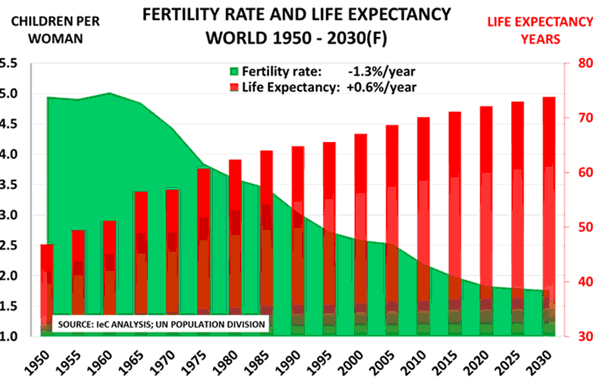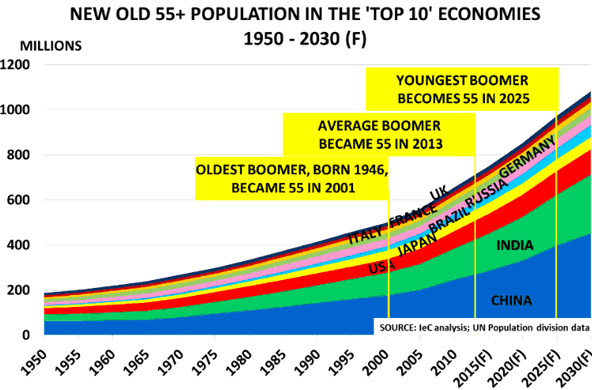February 13, 2014 2:22 pm by FT
Two remarkable global demographic developments have occurred since 1950. Yet only recently have their impact on companies and the economy begun to be properly understood.
Life expectancy has risen by 50 per cent since 1950 (red column) to average around 70 years today, due to advances in disease prevention and knowledge about healthier lifestyles.
Total fertility rates have halved over the same period (green shading). The average woman now has only 2.5 children, as increased life expectancy means large families are no longer so essential for economic survival.
The global baby boom of 1946-70 was until recently critical to economic growth as record number of boomer babies joined the wealth creator 25-to-54 age group when consumption normally peaks. But now these ageing boomers are creating a large generation of people aged over-55 years for the first time in history.
The numbers of those in this 55 plus generation will double to 1.1bn between 2000 and 2030 in the world’s ten largest economies – responsible for two-thirds of global GDP.
This “new old” will be 54 per cent of Japan’s adult population (those aged over 20) by 2030 versus 38 per cent in 2000; 41 per cent in the US versus 29 per cent; and 25 per cent in India versus 17 per cent.
The most dramatic rise will be in China, where their percentage will have doubled to 41 per cent.
Household consumption contributes a minimum of 60 per cent of GDP in all western economies, so this shift is already having a major impact. Household spending declines quite rapidly after the age of 55 as older people essentially represent a replacement economy. They already own most of what they need, whilst their incomes decline substantially as they enter retirement.
The emergence of this generation is also beginning to impact businesses. One reason for the recent decline in profits at previously-successful Lanxess is the demographic changes under way in European auto markets. Its core product is used in tyres, where demand is falling as Europe’s ageing population drives less, delaying the need for replacement tires.
However, an ageing population creates major new opportunities as well as challenges. Better health means 80 will often be the new 60 for this generation. With their numbers growing nearly 3 per cent a year, they offer major growth prospects for companies agile enough to develop new products and services to supply their currently unmet needs.
The successful companies of the future may well be those who act on the insight of telephone inventor Alexander Graham Bell, that “sometimes we stare so long at a door that is closing, we see too late the one that is open”.


